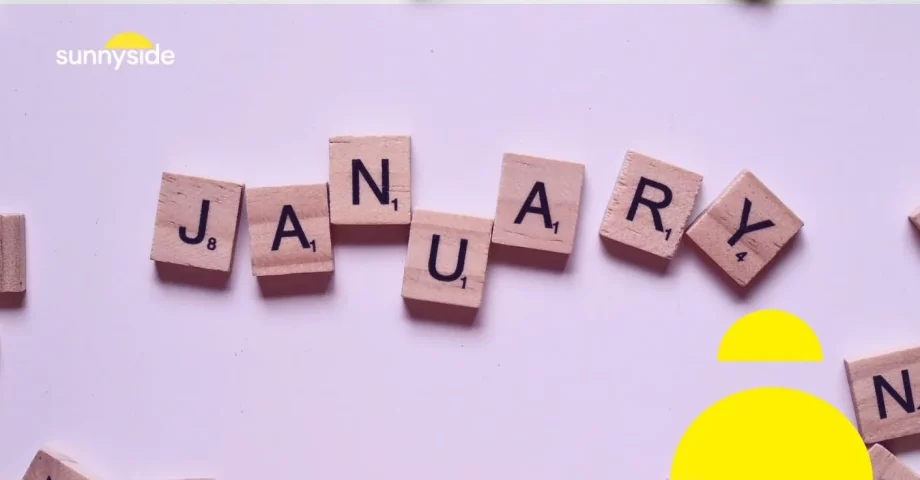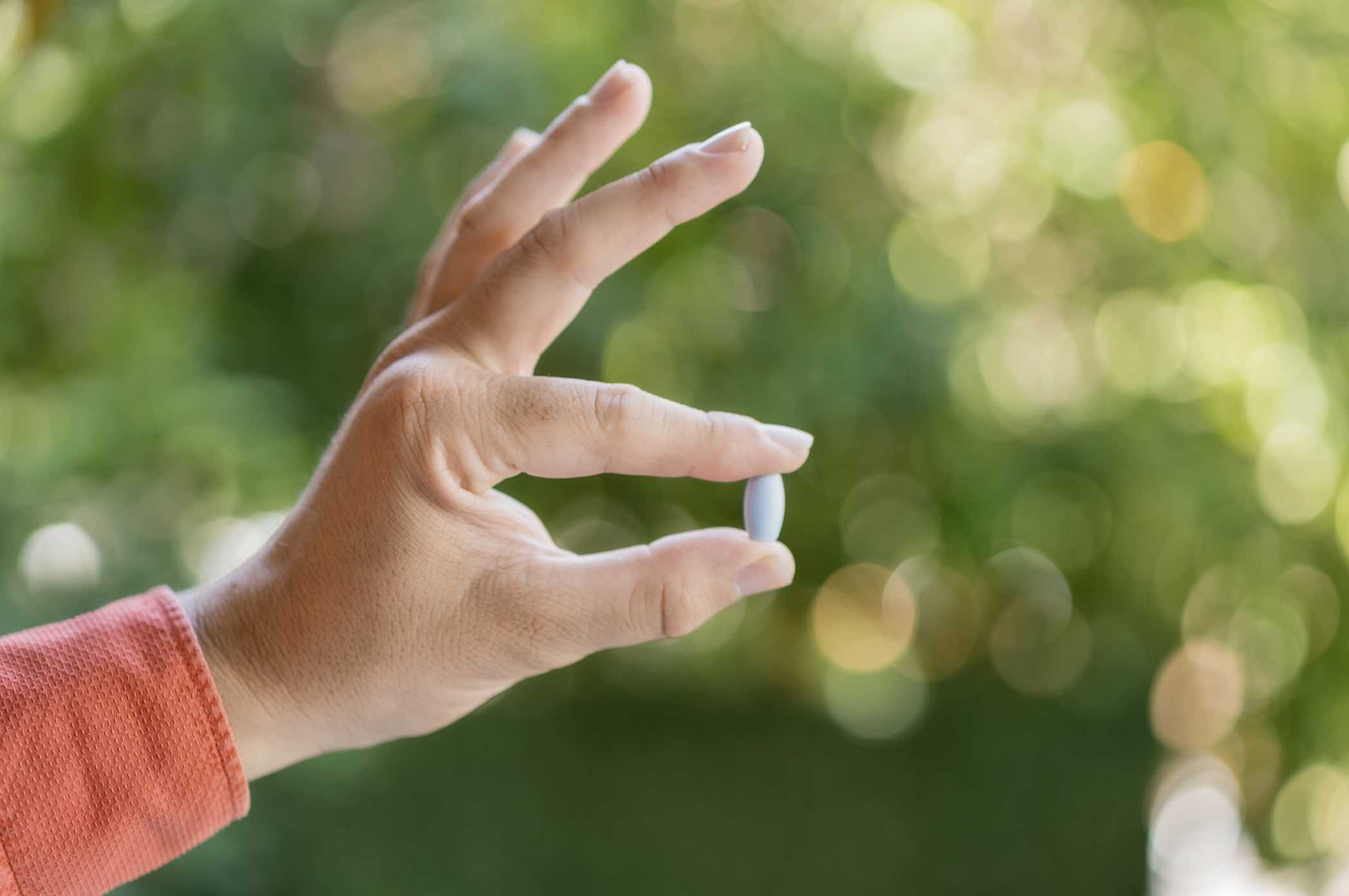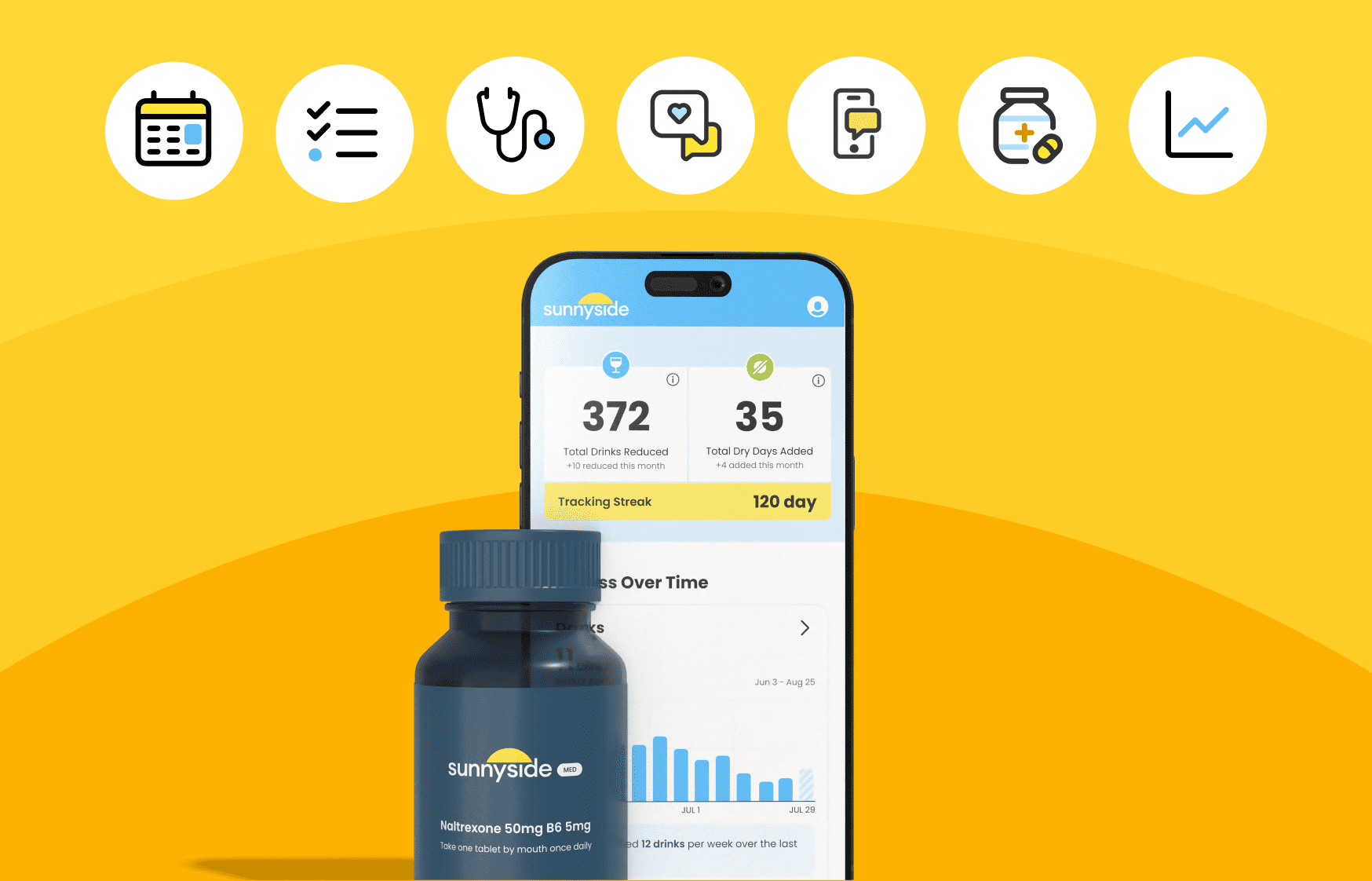Last Updated on November 27, 2024
More Dry January 2025 Resources
- 80+ No and Low Alcohol Drinks to Get You Through Dry January
- Dry January 2025: Everything You Need to Master The Challenge
- 31 Days of Mindful Activities to Do During Dry(ish) January
- Why even a Dry(ish) January Can Have Massive Health Benefits
- 15 Tips to Maximize Success During Dry(ish) January
- 10 Effects of a Dry(ish) January: A Week-by-Week Guide on What Happens to Your Body
- 18+ Tips and Tools to Crush Dry(ish) January and Build Better Habits in 2024
- Planning for Dry(ish) January: How Focusing on Habit Science Can Help
- Dry January Date Ideas: Spark Romance without Alcohol
Skip to the more popular sections:
- What’s New for Dry January in 2024
- Useful statistics about the impact of Dry January
- Success stories from real people about Dry January
- Deciding if Dry(ish) or Dry is better for you
- Helpful tips to change your drinking habits
- What are the benefits of a Dry or Dry(ish) challenge
- Apps and tools to maximize your success
- Sunnyside’s Dry(ish) January challenge as a moderate approach
**Dry January is a trademark of Alcohol Change UK. Sunnyside is not affiliated with Dry January and this article is meant to be an educational resource.**
Dry January is a challenge that brings people together to notice their drinking habits for one month. It’s meant to inspire you to drink less by noticing just how great you feel by the end of the month. Now, a Dry(ish) January is also making headlines as a more inclusive challenge to those not wanting to quit cold turkey.
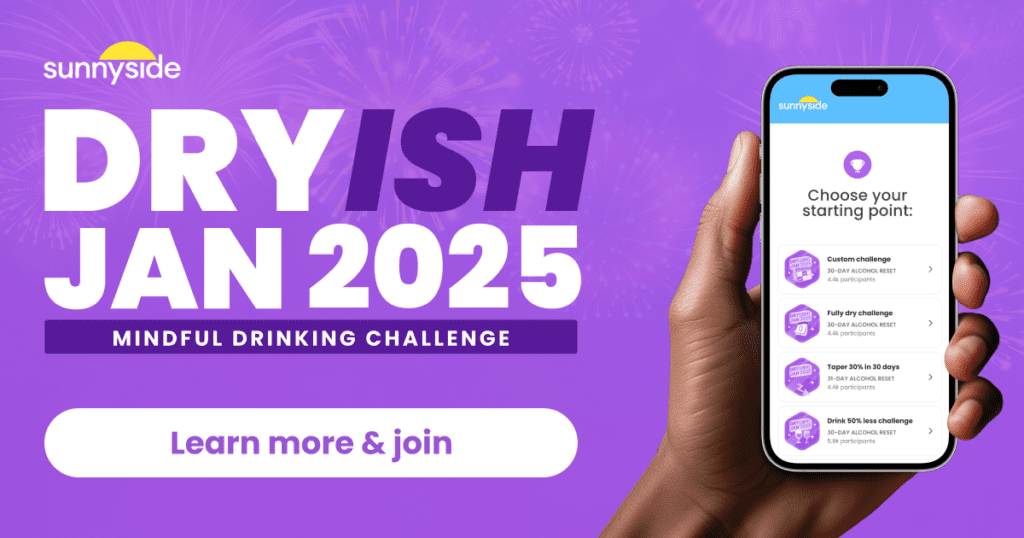
At Sunnyside, we focus on encouraging you to slowly work toward manageable goals that suit you best. That’s why we fully support a Dry(ish) January, letting you be in charge of doing things at your own pace. You don’t have to commit to a full month without alcohol if you don’t want to, and you’ll be supported by millions of other people choosing to do the same.
Using the latest research to back up our info, tips, and coaches, we hope to help you on your personal journey to better health. Read on to find out exactly how to make a Dry or Dry(ish) January work for you.
[Updated] What’s New in Dry January 2025?
This January, we’re trading in our wine glasses for a different kind of buzz — the excitement of the biggest-ever Dryish January Challenge.
The data on the last few years prove that the dryish trend is growing. Light and non-alcoholic drink sales are rising, mindfulness is flourishing, and people are ready for a challenge that lets them redefine their relationship with alcohol on their terms.
So let’s dive into what’s fresh on the horizon for your Dry January 2024:
Dry January Innovative Initiatives
Long gone are the days of hanging high and dry all on your own after you’ve decided to drink less. Now, health and wellness organizations globally are offering all kinds of workshops to impart the tips and tools we need to create change. From mocktail masterclasses to meditation sessions, there’s something for everyone.
This year, try signing up for something new to help relieve stress and make mindful drinking easier, like art journaling, bowl carving, or group sound bath meditations. It might sound way outside your comfort zone, but you never know what kind of people you’ll meet or a life-long hobby you can pick up. You can also think about signing up for a yoga or nature retreat to get away from your day-to-day stressors and take a reset during the challenge.
Endorsements of Dry January
Last year, celebrities went candid and told the world they’d be doing the DryJanuary challenge right alongside everyone else. Bella Hadid, the 26-year-old supermodel, cut down on her drinking and became a big fan and partner of non-alcoholic adaptogenic drinks from Kin Euphorics. The ingredients range from fruit juices, vitamins, nootropics, botanics, and adaptogens to help you feel your best. So if you’re looking for something more than a regular mocktail, Kin might become your new go-to drink.
Tech Support and Tools for Dry January
The digital world is brimming with support for Dry January 2025. Apps are offering tracking tools, daily motivation, and virtual support groups to keep you committed.
The Saying When app is another free resource that focuses on identifying your triggers and was designed by Canada’s Center for Addiction and Mental Health.
Innovate UK also supported the release of the app Jitai in 2023, which stands for “Just In Time Adaptive Intervention“. It’s meant to support you right when you’re most vulnerable. It offers tools and techniques like journaling, mindfulness, breathing exercises, and a customer motivation board to help when temptation hits hard. You also get an alcohol workbook with personalized insights to help you understand what techniques work best.
If you’re considering a more moderate approach to Dry January, Sunnyside’s Dry(ish) January challenge is the only option that is focused on long-term habit changing and mindful drinking.
Sign Up for Dry(ish) JanuaryDry January in Podcasts and the Media
With the ‘sober curious’ movement rising, podcasts like Untangle are dedicating special series to dry challenges. So while you’re commuting or washing the dishes, you’ve got something to listen to that can help you find your “why” for drinking mindfully. Co-founder Ian Andersen was a recent guest and dove into how Sunnyside came to be and the science-backed methods behind the app. Give it a listen to learn more about how you can make moderation work for you.
Meanwhile, alcohol Change UK, the charity that started it all, also hosts their own podcast called Try Dry. Each week throughout January they interview a guest to talk about everything related to going dry and offer tips for support and guidance.
You can also find single episodes or entire shows dedicated to the moderation movement, like Take a Break from Drinking with Rachel Hart.
Plus, social media offers a huge base of people going through the challenge too. A 2023 study looked at the chatter on Twitter (X) about Dry January. Almost 75% referred to it with a positive or neutral sentiment, with the most common themes being encouragement, experimenting with nonalcoholic drinks, and benefits. So if you want to see more people on social media who are joining along with you, follow hashtags like #dryjanuary, #partysober, #sobercurious, #sober, #alcoholfree, or #mocktails.




Dry January 2025: What New Research is Indicating
In 2024, more than 25,000 people signed up for Sunnyside’s Dry(ish) January. Since there isn’t much research focused primarily on partially dry challenges, we went ahead and studied their progress to see what a soberish challenge could do.
Here are some of the results our users saw:
- People who wanted to cut back drank 22% less.
- Those who chose to go fully dry drank 61% less overall.
Regardless of challenge type:
- 29% lost weight.
- 63% slept better.
- 46% saw improved fitness habits.
- 60% improved their mental health.
- 80% felt a sense of accomplishment.
- 64% experienced more energy and focus.
- 83% said they had fewer binge drinking days.
In 2023, about 70% chose to cut back and the other 30% opted for a fully dry month. While those who went fully dry drank much less than those cutting back, both groups still benefited.
For example, there was an increase in fully dry days for both groups. This could be thanks to committing to becoming more aware of your drinking habits and mindset around alcohol, as well as drink tracking. Dry days are helpful for weight loss, liver health, improved sleep, and mood.
The top reasons people chose to participate included improving their health and gaining more control over drinking habits.
Thanks to Sunnyside’s science-backed habit-changing tools, the majority of participants continued to drink less in the months following the challenge. Participants said that Sunnyside’s daily reminders and tracking drinks were most helpful for sticking to goals.
Sign Up for Dry(ish) JanuarySuccess Stories From Dry(ish) January 2024
The beauty of this challenge isn’t just the physical benefits — it’s the powerful transformation that can happen when you see yourself making positive changes.
Increasing your sense of self-efficacy can create a domino effect that rolls over into other areas of your life. Maybe it can give you the confidence boost you need to apply for that master’s, hunt for a new job, or set better boundaries.
Take a look at just a few of the success stories from 2023:
“I am proud that on the few occasions when I drank, I did not drink to excess and I did not automatically fall back into the old habit of drinking every night.”
“I had a dry day on Saturday for the first time. I also only had 2 drinks during a work event where the event was all-day drinking. I also stuck to my 2 dry days per week (except my vacation week).”
“On days I did drink, which were few, I never had more than 3 drinks.”
“I had several Friday nights and Sundays that I did not drink. Normally I would drink from Thursday night thru Sunday.”
“Not drinking alone, and sticking to that rule.”
“I felt like I was really taking better care of myself, I felt in control of my drinking choices and health choices!”
“Actually opting to NOT drink some nights, because I didn’t want to drink!”
Each of these people experienced something positive for their mental health during this challenge. Even the smallest of changes can create long-lasting change. So whether you’re going fully dry or just cutting back, remember that every personal milestone is a success in its own right.
Sign Up for Dry(ish) JanuaryDry(ish) January 2025 vs. Dry January 2025
You might be debating whether or not you should go fully dry, but there isn’t always a clear answer — it’s about what you feel ready for. To help you figure out what that might be, we’re going to dive into some questions you can ask yourself.
What’s Right for You?
- Why do I want to participate?
Think about your motivations. Is it purely to lose a few pounds or do you want to improve your overall health? Because if you just want to reassess and moderate, a dryish approach might work.
- What’s my relationship with alcohol like?
Reflect on your drinking habits. If you think you might be dependent on alcohol, going fully dry can be dangerous. You’ll want medical guidance, so speak to your doctor first. Otherwise, focusing on mindfulness and moderation could be the way to go.
On the other hand, if drinking is more of a habit that’s gotten out of hand (i.e. not addiction or dependence), a fully dry challenge could be manageable.
- How do I handle challenges?
Consider your personality. Do you thrive with rules or does having a bit of leeway reduce pressure and stress? If going fully dry feels too restrictive and causes some anxiety, planning for a dryish month might be better.
- What kind of support system do I have?
Your environment is going to play a huge role. If the people around you are heavy drinkers, for example, a fully Dry January might be difficult. But, if you tell others of your plans and you’re supported, you might have the backing you need to go fully dry.
- What are my long-term drinking goals?
Are you aiming for full sobriety or a bit of a reset and reassessment? If you just want to test the waters and become more mindful, a fully dry January might be insightful. If it’s just to build healthier habits, a dryish challenge could be enough.
- How will the challenge impact my mental health?
Think about what’s realistic and manageable enough that it won’t cause too much pressure or stress. Also consider the social aspect — will you be able to hang out with friends dry or does moderation sound better?
- Am I ready for potential setbacks? How will I manage them?
There are always going to be obstacles to overcome, whether or not you decide on a dry or Dryish January. Think about what might make things difficult for you ahead of time and plan how to work around it.
Finally, don’t forget the importance of self-compassion throughout the challenge. It’s not just for slip-ups, it’s for recognizing all the positive steps you’re taking to improve. Science shows that recognizing our small successes helps make the journey smoother, and potentially even further. The way you speak to yourself isn’t just to catch that self-critical punitive voice, but to acknowledge your effort, too.
In the end, the choice is yours. Just remember that your choice should feel nurturing, not punitive.
What is the Dry January Challenge?
Taking advantage of the ‘new year, new me’ hype, the Dry January Challenge encourages people to give up drinking for one month. It originated with a charity called Alcohol Change UK in 2013 with just 4000 people participating.
Now, it’s become a global phenomenon with over 30 million in the U.S alone ready to sign up in 2024, and millions more around the world. With almost a decade worth of challenges completed, people are convinced it’s worth it as the research is pouring in showing its mental, physical, and cash-saving long-term benefits.
Sign Up for Dry(ish) JanuaryWhen does Dry January start and end?
Just like new year’s resolutions, Dry January begins on the first day of the new year, January 1st. The difference, however, is that this goal has a finite end date of January 31st. You might not think it, but this one detail changes everything.
“A goal without a deadline is just a dream”.
One of the biggest problems with New Year’s resolutions is that people start with so much motivation and try to tackle too many goals at once. With no end in sight and too many hurdles to overcome too quickly, it turns into an impossible challenge too difficult to maintain long-term. After all, motivation doesn’t last, so neither do resolutions.
The key ingredient to long-lasting change is manageable habits with realistic deadlines. This challenge gives you a specific end date and encourages you to do it on your terms. If you’re not ready to completely cut alcohol from your life, that’s ok. This challenge lets you become more aware of your habits and help you notice where you can begin to reduce drinking.
Sign Up for Dry(ish) JanuaryWhy do people choose to have a sober January?
After many holiday parties and a few weeks of overeating holiday treats, the idea of starting on January first takes advantage of people often feeling at their worst. We all know that sluggish feeling we get after eating a big meal, too many drinks, or a long night out, and the holidays are full of them. There always seems to be an event going on and alcohol is usually the drink of choice at get-togethers.
Motivation is highest at this time to make changes and feel better. The number one reason people choose to sign up for the challenge is to feel healthier overall. Research proves it’s full of health benefits, like a lower risk of developing cancer, heart disease, liver problems, better sleep, skin, and energy levels, weight loss, and to top it off, more cash in the bank.
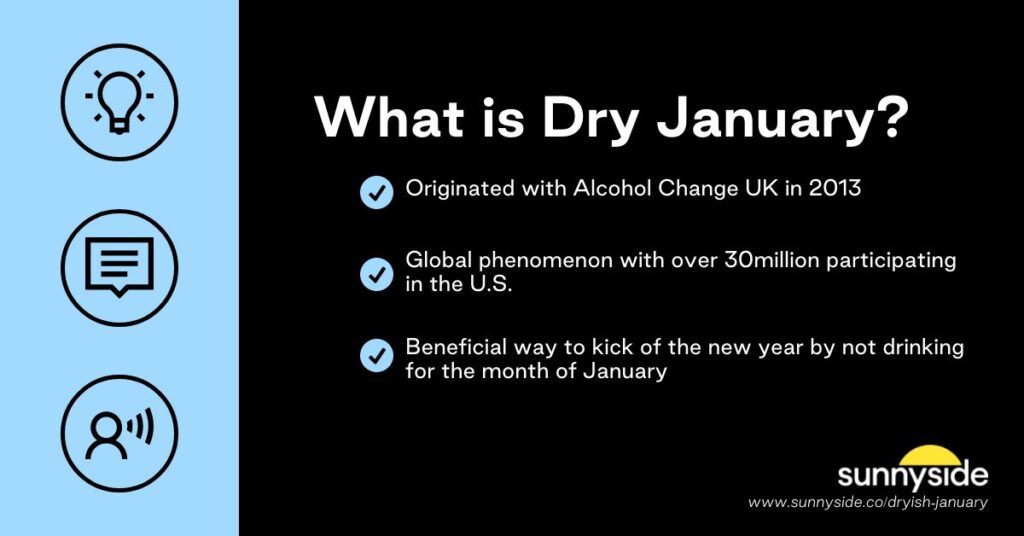

How to prepare for a successful Dry January
There are many ways to set yourself up for success this coming January. If drinking is your usual way to unwind or a regular part of your social life, it’s going to take some planning. Preparing for the specific hurdles you’ll encounter will help you not only feel more capable but also give you a go-to action plan for whatever stands in your way.
As the old saying goes, failing to plan is planning to fail.
Look over these tips and choose one or two that you can begin to focus on. Once you feel like you have a handle on them, come back to this list to choose another. Each one can set you up for long-term healthy habit changes, whether it’s to do with drinking or not. You might be surprised about how changing just one habit can change so many other areas of your life.
Sign Up for Dry(ish) JanuaryHere are some tips to help you change your drinking habits
1) Stock your house with tasty alcohol-free beverages. Whether it’s mocktails, alcohol-free beer or wine, or sparkling water with fresh lemon, having a replacement to grab when you feel the urge can satisfy the craving. Also, make sure to keep alcohol out of the house to make it easier on yourself. “Out of sight, out of mind” makes a difference.
2) Let friends and family know. If you have people in your life you trust, let them know your plans and that you’re looking for support. Writing down your goal and confiding in a friend can increase your chances of getting something done by over 60%! Plus, if you do a weekly accountability email, you’ve raised your odds to 74%.
Whether it’s a habit to drink less or something else, one good friend, accountability buddy, or therapist to keep you in check, makes a difference.
3) Join a community. Download apps, like Sunnyside, and become a part of a community of supportive people ready to go through the month with you. Feeling socially supported and a part of a group increases your likelihood to succeed. If your goal is to cut back instead of going cold turkey, you can also use apps to better track your drinking for the month. It’ll take out the guesswork and let you become aware of your patterns (and possibly your triggers to avoid in the future, too).
4) Practice turning down a drink. While it might feel silly or like you’re rehearsing for a play, visualizing yourself doing something makes it more likely you’ll do it. The science doesn’t lie – it’s worth a try! Some phrases that might work:
- Not tonight, thanks.
- Maybe later.
- I’ll have something else.
- I’m doing Dry January! Feel free to join me if you like.
- I’m cutting back and I’d really appreciate your support on this, it would help me out a lot.
- Nope, none for me, thanks.
- I don’t drink.
And if someone is being particularly difficult, you can always throw this one out at them:
- Don’t sober-shame me.
You might be surprised at how hard of a time you have saying these sentences! The good news is, it gets easier every time you say it.
5) Prepare for any backlash. Hopefully, you’ve joined a group online or have a few supportive friends you can count on to cheer you on. Some people, on the other hand, might respond negatively, as though personally hurt you’re not drinking with them. It’s a common human response usually driven by fear.
Maybe your friend is worried they’ve lost their drinking buddy. For others, they might know they should cut back but aren’t ready and shame might be the underlying emotion behind unsupportive comments. Others may feel attacked and reminded of their own issues, with jealousy coming out.
Go over some responses you can give and remember that overall, it’s your choice and you’re not responsible for how other people react to it.
6) Learn how to change a habit. Whether it’s podcasts, books, or blogs, start reading up on the most effective habit change practices.
For example, in James Clear’s book, Atomic Habits, he speaks about habit stacking. That’s where you take a habit you already have and use it to introduce a new one. He uses the “after _____ I will ______” practice. For example,
After I brush my teeth in the morning, I will drink a tall glass of water.
You can use this for any alcohol-related habits you have.
For instance, if grabbing a drink is usually the first thing you do after finishing work, you could try this:
After I get home from work/As soon as I close the laptop when working from home, I will…
- Make a cup of tea or pour a glass of sparkling water
- Change clothes and head outside for a walk
- Sit down and relax with a non-alcoholic beer
If alcohol is what calms you after a long day, take some time to experiment with other calming habits to replace it.
Another example could be,
When I meet friends for drinks, the first drink I order will be non-alcoholic.
Or
When I meet friends for drinks, every other drink I order will be non-alcoholic.
Choose whatever is easiest. The bigger the difference from your current routine, the harder it gets. With time, you can adapt and change your habits, but for the moment, focus on simplicity and ease.
7) Try the ‘not twice in a row’ rule. It’s easy to lose focus now and then and end up with a drink in your hand. Allow yourself to be human and accept that change doesn’t happen overnight. While society likes us to believe it’s all about willpower, it’s not so simple.
We’re creatures of habit and change takes time and preparation more than anything else. So if you’ve had something to drink, that’s fine. The next time temptation or old habits pop up, remind yourself of your ‘not twice’ guideline, and reaffirm your decision to commit. Maybe another time you will have a drink, but if you can aim to not repeat the old behavior you’re trying to change at least twice in a row, you’re improving your ability to change any habit down the line.
8) Journal your progress and setbacks. With journaling, you can see what works, and what triggers and challenges you. The more you observe your behaviors, the easier it becomes to see what needs changing and how you can make that happen.
Keep in mind, the smallest of changes can create a domino effect. For example, going for a short 15-minute walk after dinner gets you out of the house and away from temptation. But it also moves your body, lowers stress hormones, allows your brain to process emotions better (helping you to unwind), regulates breathing, and aids in digestion and weight loss.
9) Make it about more than you. If doing this for yourself isn’t quite motivating enough, think of who else you can do this for. Add a new element that makes it worth it, like a charity you believe in or a loved one who wants change and is ready to support you.
The charity that made Dry January famous, Alcohol Change UK, supports people trying to change their drinking habits. You can raise money or awareness for them as part of your Dry January Challenge. Some people say they’ll double a donation made by friends if they have a drink. Think of whatever you feel would give this challenge meaning, and use it to keep you strong.
10) Get social. If your usual idea of socializing is grabbing a drink with friends, try encouraging them to do something new and physically active together, like going for a hike, ice skating, or trying a salsa class or paintball game. If they won’t change, you can join other communities and use this as a push to get out of your comfort zone and expand your social circle.
11) Let your creative juices flow. Alcohol is not just a habit but often a stress-soothing response and a way to relax. Since you’d like to cut back, find new outlets to let out your stress and emotions so they don’t stay inside of you and push you to drink.
Maybe you’ll finally try that dance class and feel the energy overflow to other areas of your life. A pottery, painting, or photography class can open a whole new world of creativity you never knew you had.
Any hobby that gets you out of the house and expressing yourself is going to lower stress levels, get you meeting new people, and create the opportunity to improve your overall mental health.
12) Practice compassionate self-talk. If alcohol is a regular part of your life, signing up for this challenge may not be easy. If you’re ready for it, it might go more smoothly than imagined. But between temptation, peer pressure, and old habits, it is very much a challenge.
If you find it difficult and you’ve had some alcohol, that’s ok. The challenge is meant to encourage you to begin changing old habits with the support of others doing it with you. If you’ve had some slip-ups, being compassionate with yourself will give you the best chance of getting back to the challenge when you can.
Overall, compassion is one of the biggest predictors of improving mental and physical health. Beating yourself up doesn’t work – and if it’s how you usually talk to yourself, you may already have evidence of that.
13) Let go of the ‘all of nothing’ mentality. Just like how overly restrictive dieting and self-shame contribute to anxiety and eating disorders, criticizing yourself and setting too harsh standards or unrealistic goals can lead to depression and anxiety, furthering the desire for substance abuse and addiction.
You’re only human, so it’s completely natural to not do everything perfectly. Learning to accept that is a process that takes time, so this is where compassion comes into play. Set realistic goals and if they don’t work, re-assess and set new ones. Let yourself be open to flexibility and making mistakes, that’s how we learn after all.
In the end, remember that how you talk to yourself matters. Working to reduce negative self-talk helps people recover from depression and anxiety and influences their ability to complete their goals. So keep reminders around and get on the trend to “talk to yourself like you’re talking to your best friend”. It may sound silly, but it’s got science to back up that it works!
14) Consider professional help. If you’re recovering from alcohol addiction or classify as a heavy drinker (more than 15 drinks a week for men and 8 for women), an extra support system, check-up, and professional guidance will let you know the best course for you. Heavy drinkers aren’t recommended to take part in the challenge as they may be dependent on alcohol and quitting suddenly is extremely dangerous.
Meanwhile, if you’ve been struggling with anxiety, depression, or are feeling lost, a therapist might be your best bet. They can be your accountability buddy and help you learn the tools you need to adapt to drinking less while helping you work towards improving other areas of your life that cause you to drink.
One of the biggest reasons why people drink is to escape negative emotions, like stress, frustration, anger, boredom, helplessness, or loneliness. Most of us weren’t taught how to manage our emotions as children and so we grew up keeping it bottled inside or turning to substances or people (yes, unhealthy relationships can be an addiction) as a way to cope.
If you weren’t allowed to express yourself fully as a child and grew up with emotionally unavailable or immature caregivers, healthily coping with life stressors and developing self-esteem must be re-learned as an adult. Fortunately, with the help of a therapist (and some good books and support systems) you can learn how to manage difficult emotions without turning to substances.
If you’re not sure if you classify as a heavy drinker or what would work best for you, you can try a free helpline to get some guidance as to what would work for you.
How to Prepare for Dry January 2024:
Whether you decide to jump in last minute or have thought about it months in advance, you can go through these steps to get your mindset in the mood for Dry January:
- Think about your “Why”
Before starting any challenge, we need to have a very clear reason as to why we’re ready to do it. Because when things get hard, that clarity can help you continue on, despite the difficulty. Take a minute to think about what’s most important to you. Is it to increase self-confidence? Improve your health? Why is that important to you? What do you want to gain from this experience?
- Educate yourself
Sunnyside’s blog is full of free mindful drinking resources. Learning exactly what alcohol does to your body, like how it affects your brain, mental health, liver, and sleep, for example, can make your “why” much stronger — and your chances of success even higher.
- Plan non-alcoholic alternatives
Don’t worry about becoming a shut-in in January. Reach out to friends with suggestions for alcohol-free activities ahead of time. You can also plan to sign up for new classes for January to keep you busy. Plus, you can still join events with alcohol involved if you like, just think of non-alcoholic beverages you might want to try.
- Practice mindful activities
Mindful drinking can get easier when you practice mindfulness throughout your day. No need to feel pressured into creating a lengthy morning routine full of yoga and meditation. Mindfulness is simply taking a moment here and there to be present. Let yourself pause to notice something calming, to fully appreciate seeing a good friend, or while eating a really nice meal.
- Seek support
Social support is one of the most important factors in our mental health. We’re not built to handle everything on our own, so reach out to friends or family you can trust. Otherwise, think about joining a support group or a community within a hobby you love to meet new people.
- Prepare for challenges
There are always ups and downs, but preparing for those hard times can help you move through them a bit more smoothly. Think about what obstacles might get in the way of sticking to your challenge during the month. For example, certain people, places, habits, etc. How can you overcome these challenges?
- Celebrate your wins
Why do we always forget to congratulate ourselves for a job well done? It doesn’t have to be anything big, but just recognition of, “Hey, I can do this.” or, “I only had two drinks instead of my usual 5 when I went out with friends — that’s progress!”
Constant self-criticism doesn’t usually get us very far, so why not try something different?
Sign Up for Dry(ish) January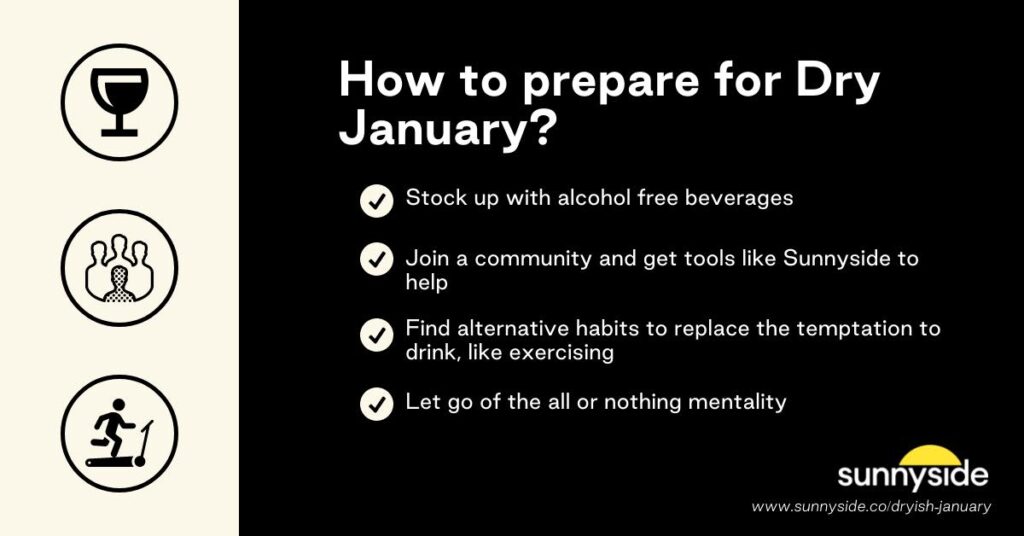

What are some similar challenges to Dry January?
If January isn’t a good month for you or it just feels like too much pressure, feel free to challenge yourself any time you like. Having others to support and cheer you on makes a difference though, so if you’d still like some support, here are some similar challenges to consider.
Sunnyside’s Dry(ish) January Challenge
All-or-nothing views around alcohol are simply not productive. Your relationship to alcohol is personal, as is how you choose to approach any January or New Year challenge.
Sunnyside’s Dry(ish) January challenge offers several ways to participate that are fine-tuned to your goals. And not someone else’s. When you sign up, you’ll be given a choice to define your own challenge. Maybe you decide you’ll only drink on the weekends. Or maybe you’ll choose to drink 50% less than what you usually consume. Or maybe you will decide to not drink at all for the whole month.
No matter which challenge you choose, you’ll be supported and celebrated throughout your journey.
Dry Feb and Defi 28 Jours Sans Alcool
Join the Belgians and Quebecois on their 28-day challenge (3 days less!).
While Canada celebrates Dry January because of its popularity, Dry Feb exists to help raise funds for the cancer society of Canada. Dry Feb also increases cancer awareness since only ⅓ of the population is aware of the increased risks of cancer from even small amounts of alcohol consumption. The fundraiser even smartly adds 14 or 21-day fundraising options.
Dry July
On the other side of the world, Australia and New Zealand are still doing things upside down by hosting Dry January in July. Like the original campaign began in support of a charity and improving people’s quality of life, Dry July works to support cancer patients. You can register yourself and your workplace, and donate to support cancer patients in need of nurse specialists, transportation, and medical improvements at home and the hospital.
Buddhist Lent Abstinence Campaign
If you’re ready for an even bigger challenge, the Buddhists in Thailand are encouraged to abstain for the entire three-month Buddhist Lent period, around July-October.
Like the one-month programs around the world, it’s been shown to have great results. A third of all alcohol drinkers in Thailand completely abstained, that’s almost 6 million people! Another 6 million changed their drinking habits, abstaining for a portion of the time or decreasing their usual amount.
Not surprisingly, research shows there are still changes in people’s drinking behaviors an entire three months later.
If holding yourself accountable for a greater cause helps you stick to your goals, try fundraising for Sober October to raise funds for people suffering from cancer in the UK. Like in other countries, donations go towards improving health care, offering financial support for those out of work due to their illness, and increasing support lines.
Dry November
Hungary takes advantage of November, before the holidays begin, to let people develop new habits before things get out of hand. They support the Kék Pont foundation, which provides healthcare, social, and legal services for psychoactive substance users who lack governmental support.
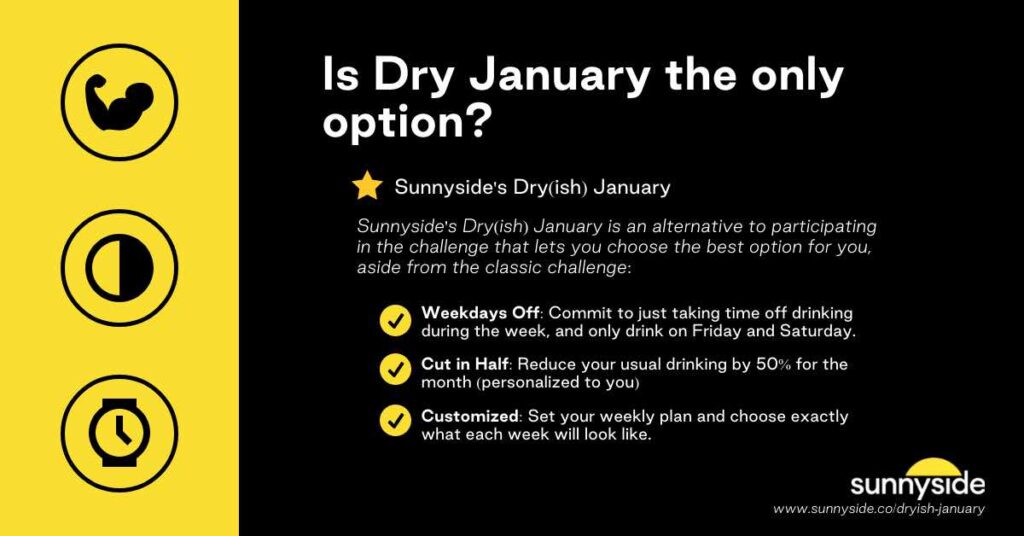

The Origin and History of Dry January
The story of how it all began goes much further back than we expect, long before it had its current buzz-worthy name. January without a drop, as the Fins called it, first took place in 1942 to help the Finnish war effort.
The country had a history of alcohol, as many do, and it was a problem for the soldiers who were on the front line for an unexpectedly long time. The government sent entertainment and alcohol to help comfort them, like music and theater performances, but the booze ended up having a negative effect on their abilities to manage the difficulties of war.
So, the campaign to come together to encourage at least one month, a sober January, throughout the country. The advertisements and newspapers gained huge popularity, with even restaurants participating and offering pints after the event was done.
The U.K takes over
The campaign went quiet after the war until Dry January officially popped up again in 2013. A charity called Alcohol Change UK put together its first public campaign with 4000 people taking part. It had nothing to do with the Fins, it was just one woman focused on improving her health who ended up creating a worldwide call for change.
The year before, a new employee at the charity, Emily Robinson, joined the U.K team and everyone became so impressed with how she gave up drinking in January to prepare for a half marathon in February. They began talking about all the benefits just one month could have and the fantastic timing of going dry after the sluggishness that follows Christmas festivities. They spread the word and got columnists to back the campaign. They also joined forces with The University of Sussex to see if one month really made a difference in drinking habits and health effects, both short and long-term.
By the following year, the number of people joining jumped to 17,000. Large groups, newspapers, and university research showed that indeed, there were benefits to just one month of drinking less. News began to spread to other countries, and it was official: Dry January was worth the buzz.
Sign Up for Dry(ish) JanuaryParticipation in Dry January Through the Ages
Dry January Pre-Covid
Each year from 2013 drew more and more participants into the challenge. Celebrities, charities, and government health groups all promoted Dry January to the public. Royal Free Hospital claimed “staggering” results from early research showing that participants lost 40% of their liver fat, 3 kg of body weight, and lower cholesterol and glucose levels.
With the growing number of people interested, the first app came out in 2016 to keep them motivated. By 2017, four million people signed up in the U.K, and even more worldwide. Impressive research from The University of Sussex also spread, letting people know that those who participated ended up drinking less even at the 6-month follow-up.
By 2019, Dry January had become a proven way to improve people’s health and relationship with alcohol, even if they didn’t completely abstain. Using it as a way to become aware of drinking habits rather than cutting alcohol cold turkey grew in popularity, allowing even more people to feel encouraged rather than intimidated to give it a try.
Sign Up for Dry(ish) JanuaryDry January 2020
COVID hit and studies showed an increase in drinking, especially among women, those with anxiety disorders or financial difficulties, and younger people. In one study, participants had almost 27 drinks on an average of 12 out of the last 30 days. To put this in perspective, more than 15 drinks a week is considered heavy drinking for men, and 8 for women.
Polls also showed that 4 out of every 5 drinkers in the U.K felt they drank too much, and 10% of them were ready for the challenge. This amounted to over 100,000 people signing up in the U.K alone.
In the U.S, about 16% of drinkers were ready to join. The challenge is now worldwide and going strong. For many though, the primary reason isn’t to cut back because of pandemic over-drinking, but to feel healthier overall.
The trend to drink less is changing not only people’s lives but also companies. Sales of non-alcoholic beer also grew by almost 40%, allowing people to feel as though they didn’t have to completely give up their love of beer. This encourages the creation of more mocktails and other non-alcoholic beverages people can enjoy year-round.
Sign Up for Dry(ish) JanuaryDry January 2021
Almost 23% of drinkers in the U.S planned to participate in Dry January 2021. To put that in perspective, that accounts for 15% of all U.S adults. The stressful effects of the pandemic still have people drinking more than usual, especially those with work and financial stress.
Working from home has also become the norm, and it’s leading to some unhealthy habits and more drinks delivered straight to the house. Awareness of the mental and physical health benefits are now widespread and the benefits of saving cash are also encouraging people to give it a try.
In the U.K, another 130,000 people sign up, showing that each year as more people find out, more people join. Awareness is helping charities to continue to receive donations and put money towards cancer research, further campaigning, and helping those in recovery.
Dry January 2022
Polls already showed in 2021 that 12% of all drinkers in the U.K planned to sign up for the challenge in 2022. For the entire U.S population, it grew from 15% to almost 19%, driven mostly by millennials. It’s also full of previous challengers, with 77% of those taking part saying they’ve done it before.
Now, many more are signing up for a Dry(ish) January than full abstinence. The popularity of cutting back rather than cutting out alcohol is growing since more and more people want to do it on their terms. With studies showing that you don’t need to abstain completely now common knowledge,
The sales of non-alcohol drinks reached staggering amounts, with an increase of almost $300 million USD from 2019 to 2022. About a third of participants say they’ll buy a non-alcoholic drink during the challenge.
Sign Up for Dry(ish) JanuaryDry January 2023
Last year, almost 20% of all American millennials participated in Dry January. They had the highest number of participants, but still, about 15% of all American adults took part in Dry January 2023.
There were fewer participants than in 2022, which had a total of 19% of all adults. There are a few theories as to why, such as fewer COVID restrictions creating some changes for 2023. Perhaps fewer people were stress drinking or there wasn’t as much media attention since people weren’t at home as much.
Another factor is that mindful drinking promotion throughout the year is increasing. No and low-alcohol or “better-for-you” beverage sales have also been rising. Lower sugar options have become available, along with flavorful mocktails. So that dip in participants might just be because people are beginning to become more mindful year-round, which is exactly what Sunnyside aims to help with.
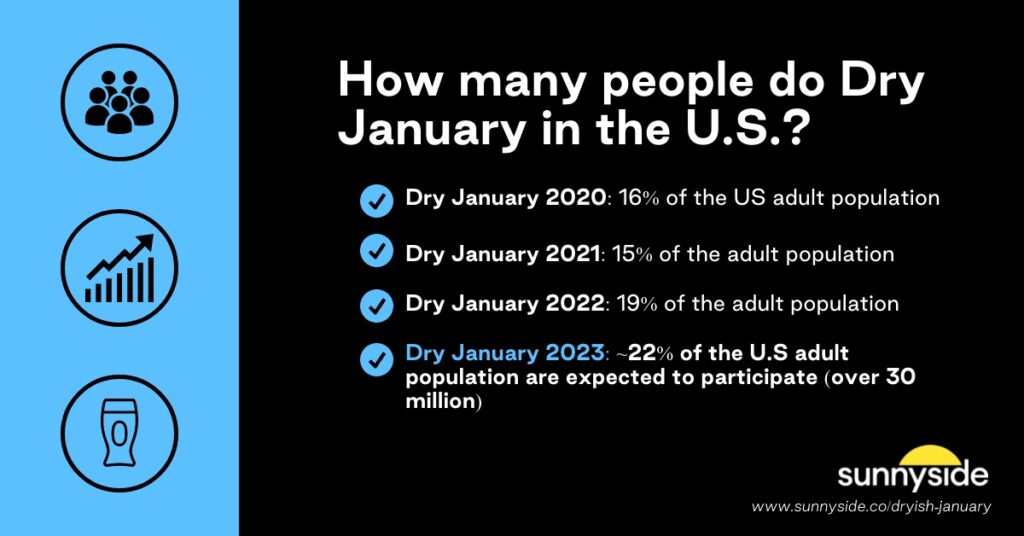

What Are Some Dry January Benefits & Considerations
1) Benefits of a dry month challenge
Whether you cut off alcohol completely or just cut back, the benefits of Dry January continue long into the future.
Healthy habits year-round
Over 70% of participants maintained lower levels of harmful drinking even six months later. A total of 4% reported they never went back to drinking at all.
Changed their relationship with alcohol
Many people were surprised to realize that not drinking can be normal. Society has made alcohol the go-to fix for a hard day or necessary for a night out, but this challenge helps people realize there are healthier ways to manage stress, and an evening out can be just as fun without alcohol.
This recognition allowed a whopping 80% of people to feel more in control of their habits and develop a new relationship with alcohol, even after completing the challenge.
Domino effect
As with any habit change, be it good or bad, a domino effect takes place where many other areas of life are affected. This challenge allowed 93% of participants to feel a sense of achievement and empowerment. People wanted to prove to themselves that they could do it, and the realization that they could spread to other areas of their life.
People gained energy and felt more capable to manage whatever came their way. This greatly affects mental health and contributes to fewer symptoms of anxiety and depression. There are also all the great physical health benefits and improved productivity at work and with personal goals.
Save money
Finally, although not a primary reason to do the challenge, around 88% of participants said they saved money. At the end of the month, the difference for the average moderate drinker was almost 100USD, but if you’re drinking several nights a week, you could save much more than that.
Let’s say you have an average of 12 drinks out per week, which is very possible for someone binge drinking two or three nights per week, and it’s about $10 a drink. That’s $120 a week, almost $500 a month, and $6000 a year on alcohol. If $10 seems high for where you live, you can include that with the tips, taxis, and the added food you buy when drinking (because we all know alcohol usually makes you crave something greasy).
Even half that amount, about 6 drinks out per week, is still $60 a week, $240 a month, and almost $3000 a year. Again, also consider all the other added expenses you have with a night out of drinking.
If you are having 12 drinks a week, that can be considered heavy drinking. Women only need 8 drinks a week to classify as heavy drinkers, while it’s 15 for men.
Sign Up for Dry(ish) January2) What are some health benefits of doing Dry January?
The health benefits continued long past the one-month mark, and most of the studies included people who didn’t do a completely Dry January, making the results all the more impressive.
Overall Health
Almost 70% of participants said their overall health improved. Every area of their life was affected, for example
- 57% lost weight
- 60% had better concentration
- 53% reported better-looking skin
- 71% had better sleep
Reduced drinking also improves your gut health, which not only means better digestion and weight loss but also improved mental health and a reduction in chronic health risks.
Mental Health
- 82% felt a sense of achievement
- More energy almost 70% (domino)
- Over 40% spent more quality time with friends and family
- Mood boost, likely decrease in anxiety and depression
Chronic Health Conditions
The risks of chronic illnesses also decreased, such as
- Diabetes
- Heart disease
- Liver disease
- Cholesterol
- Cancer
No Hangovers
Of course, without the usual hangover on Saturday or Sunday morning, people had less “hangxiety” and a lot more energy to take advantage of their weekend. You’d think that going dry meant seeing friends less, but almost 40% reported seeing friends and family more. Socializing and seeing loved ones more often also rolls over to decrease the risks of chronic illness and anxiety and depression, too.
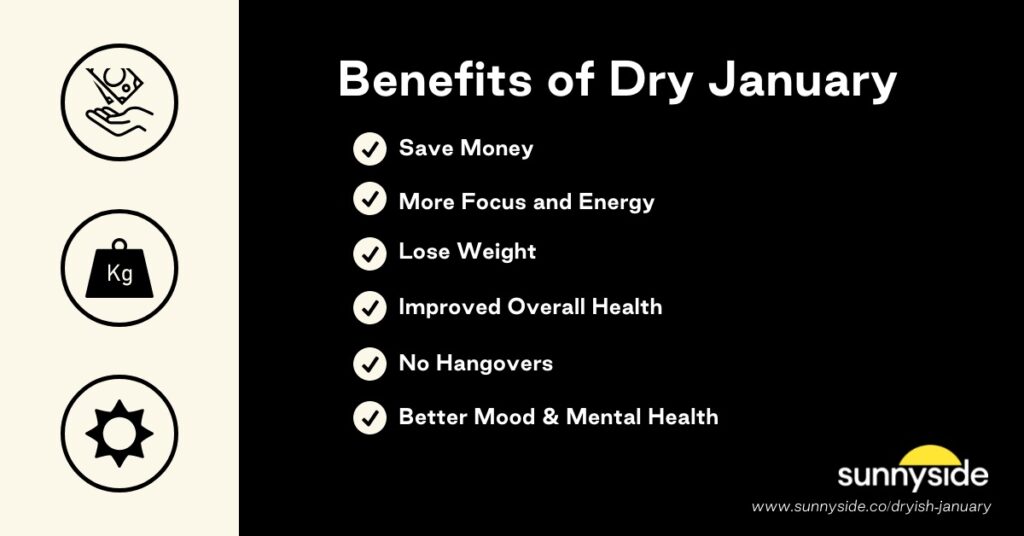

3) What are some effects and side effects of Dry January?
Are there risks to Dry January?
Overall, the benefits of Dry January exceed the negative effects. However, there are some risks to consider.
- It’s not for everyone, especially those with alcohol dependence.
- Few report an increase in drinking afterward, but overall, most people maintain better drinking habits after the challenge.
- Some mistakenly believe a one-month ‘detox’ is enough. With all the well-reported benefits, some may return to old habits after the one-month challenge, not recognizing they have deeper issues that need addressing.
- Most beneficial for heavy drinkers, but not necessarily for the general population, such as light drinkers.
- It’s not easy! If your usual response to stress or any negative emotion is to grab a drink, changing that behavior can be extremely difficult and painful. The whole idea of the program, of course, is to learn how to process negative emotions in a healthier way.
4) What are the week-by-week effects and benefits of Dry January?
While the weekly and overall benefits may be different for everyone, these are some of the highlights you can look out for week-by-week.
Week One
- More energy
- Better sleep
- Smoother mornings
Week Two
- Increased concentration
- Better memory and productivity
- Reduced stress hormones
- Taste buds changing (more sensitive/aware of sugar)
Week Three
- Brighter skin
- Reduced inflammation
- Less bloating
- Weight loss
- Better overall gut health
Week Four
- Better relationship with alcohol
- Increased sense of accomplishment
- Awareness of drinking habits
- Less overall anxiety
- Extra cash in the bank
5) What is a Dry(ish) January?
Following a Dry(ish) January means you set your own goals for the month. There’s no need to cut alcohol off completely and feel deprived, so you can join in on your terms and use the challenge as an opportunity to observe your current drinking habits.
How to prepare for a semi-dry January
You can use all of the tips to follow a fully Dry January while including some changes, such as
- Make a goal for how much you’d like to drink during the month
- Have your goal be as specific as possible. Make it by the week or weekend, include any special events, and plan for trying an event alcohol-free or with certain drink limits (or not).
The benefits of drinking less even if you break your Dry January streak
Luckily, you’ll still have most of the benefits as fully abstinent drinkers. This includes
- Weight loss
- Better sleep
- Improved mental health and energy levels
- Decreased risk of chronic illnesses
- More money
- A healthier relationship with alcohol long-term
Can you have cheat days in Dry January?
That’s entirely up to you – there’s no pressure to do a fully Dry January if you’re not ready for zero alcohol. It’s healthier to recognize your needs and boundaries and set your goals accordingly.
Maybe there’s a big event happening or you’re too nervous thinking about going cold turkey. You can avoid that unnecessary pressure or anxiety and instead, focus on changing habits little by little rather than all at once. Use the challenge as a gentle push towards a healthier lifestyle rather than a cliff dive into rocky waters.
Sign Up for Dry(ish) January6) What happens when you feel like quitting Dry January
Where can you get support for achieving your Dry January goals?
If you’re finding it difficult to get the support you need from family and friends, encouragement can be found online. Check out communities through apps, charities, and even social media. For example
- Try the Sunnyside app, where you can get cheered on by a community and private coach
- Alcohol Change UK, the charity that started it all offers free resources and ways to get involved
- Social media, follow accounts that promote mindful drinking and inclusivity to all those looking to develop healthier habits
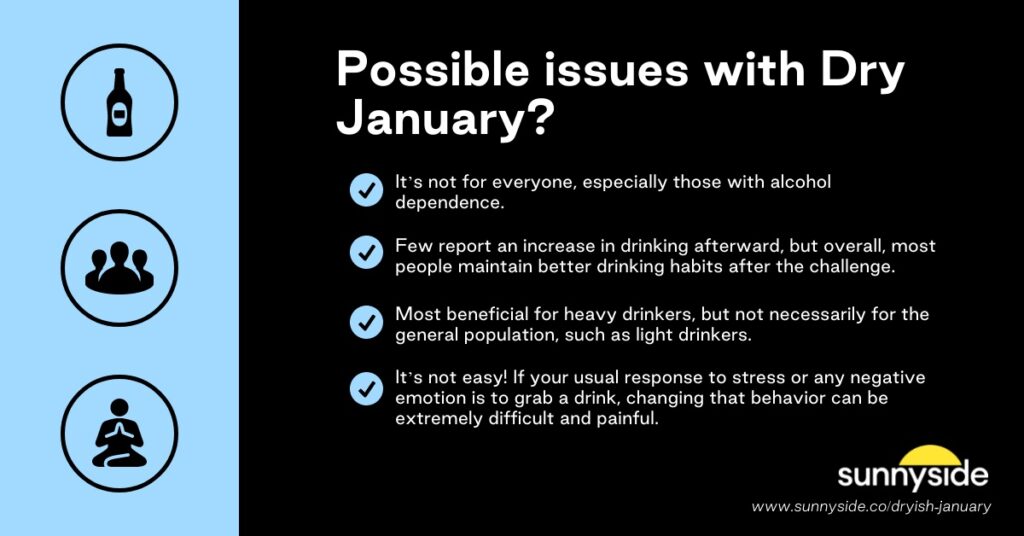

Tips and Apps to Help You with Dry January
1) What are some of the best apps and tools to support the Dry January Challenge?
Sunnyside’s Dry(ish) January Challenge
Focusing on progress rather than perfection, Sunnyside helps you set realistic goals. You get weekly plans, daily motivation and tips, and progress measurements to help you see just how far you’ve come (like total drinks saved, nights of great sleep, and calories avoided). Unlike other apps, Sunnyside fully supports you with a Dry(ish) January on your terms.
Right after a 3-minute quiz, you get a personalized plan for your goals and current habits. There’s no pressure to quit cold turkey, and everything is tailored to your needs and lifestyle. Coaches are always available to be your accountability buddy, along with a big community of people also trying to get healthier and cheering you on.
With over 200 zero-proof cocktail recipes, inspirational stories and tips, and instructional videos by bartenders to encourage you to try new flavors and perfect your old favorites, this app’s got it all to keep you loving what you drink, without the negative side effects.
This app covers everything health-related that’s going to get your energy levels up and help maintain new habits. It tracks your sleep, training, recovery, goals, and habits, to change your life for the better, long-term.
Noom uses behavioral science to help people change old habits. What began as a weight-loss app now covers chronic and non-chronic conditions, such as stress and anxiety, hypertension, and diabetes. They use cognitive behavioral therapy (CBT) techniques along with live coaches to help you reach your goals.
This free fitness app is most famous for counting calories, but they now include goals outside of weight loss. You can track your drinking habits here, join a community of like-minded people, and be inspired to get more active and eat nutritious and delicious food.
Sign Up for Dry(ish) January2) What are some alcohol alternatives to help get through Dry January?
Ritual
This liquor replacement company is getting rave reviews for its incredible products. They sell everything from zero-alcohol gin, tequila, rum, and whiskey – each one tasting like the real deal. On top of that, it doesn’t have sugar, meaning you don’t crash afterward (or have a hangover!). They also have zero-calorie options and tons of healthier recipes for mocktails on their web, making the usual weight gain from alcohol a thing of the past.
Athletic Brewing
Award-winning and vegan-friendly non-alcoholic beer that tastes great. They’ve got tons of different flavors for every occasion and a $10 off coupon when you sign-up, too.
Libra Beer
If you’re looking for a craft beer, look no further. Their ale flavors will blow you away (there’s even a pumpkin spice option!). They’ve won world beer awards, and come with low calories and a discount code when you get a 36-pack delivered.
Seedlip
Tasteful and beautifully created cocktails are their specialty, like the Espresso MartiNO, Spice Ginger Highball, or Pineapple Jalapeño Margarita. Get 10% off your first order and try something new for yourself or surprise friends with their great flavors (even the names, like ‘Grandad’s Favorite’ and ‘Hedge Your Bets’ make for fun conversation starters).
Leilo
Using the calming Kava plant from the Pacific Islands, leilo has many flavors of ‘calm in a can’. Their creative drinks and medicinal qualities come in fruity, low-sugar, and citrus flavors. They even have one called ‘Luna’ with kava and melatonin to help you relax and fall asleep.
Ghia
They’re masters of recipes, wit, and non-alcoholic kits. Almost all their drinks come vegan, gluten and caffeine free, with no artificial flavors or added sugar, and kosher. Ghia has tons of products and puts effort into making them fun, including aperitifs and puzzles for a game night. As they say, “We took out the booze and the fake stuff—but we kept in all the attitude”.
Sign Up for Dry(ish) January2) Find an accountability partner
While it’s great to invite your friends to participate in the challenge with you, you can also rely on Sunnyside coaches to keep you motivated and accountable with Dry(ish) January.
Sign Up for Dry(ish) January3) What are some other alternatives to Dry January?
Do a Dry(ish) January
Instead of cutting off alcohol, think of a balance that would work for you. Use the same tips and tricks as for a fully Dry January and consider these options as well
- Make a goal for how much you’d like to drink for the month
- Track your drinks to better understand your habits, reassess your goal if needed
- Considering drinking only
- Certain days of the week
- Alternating weeks
- Only for events
- Half the amount as usual
And most importantly, as with any habit change, plan for how you’ll manage any obstacles or difficulties you’ll face along the way.
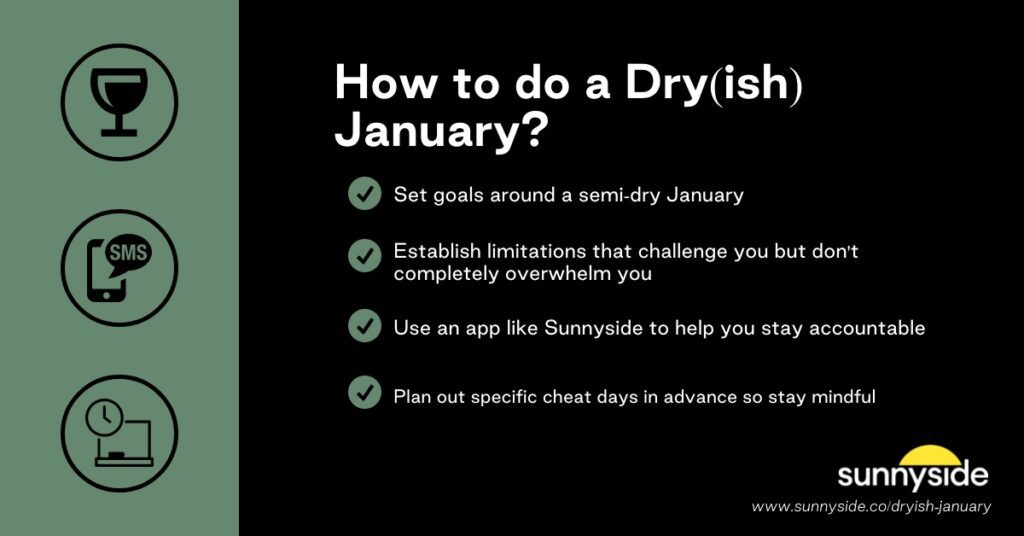

What happens after Dry January?
1) How to transition back into drinking after Dry January
Tips for maintaining mindful drinking habits without overdoing it once the month is over and important questions to ask yourself:
A) Why do you want to drink again?
- Reflect on your dry month to see what your motivations are for drinking again.
- Is it a positive and empowering choice or does it bring negative feelings?
B) Think about how you want to re-introduce alcohol to your life. Would you like to continue drinking mindfully?
- If you do start again, would you like to go back to how things were before?
- What happened this month that you want to maintain or change moving forward?
C) Imagine yourself one and six months from now – what goals with your drinking habits do you have?
- What do you have to do each week to continually commit and ensure you’ll reach that goal? Make a plan for challenges you might face.
For example, if you want more than water, what are some non-alcoholic drinks you could try?
- Are you prepared to say no to people who offer you a drink? What’s your go-to response?
- What will you do next time you’re stressed and want a drink?
- What worked and didn’t work during your dry month? Use the month’s data to let you know what you need to work on.
D) Track your drinking habits and goals in Sunnyside to avoid falling back into old habits and missing your goals.
E) Consider journaling at least once a week to observe what triggers you to drink, and what helped in the past, and brainstorm what you can do in the future. Seeing things written out helps you feel more in control of your habits.
F) Join a community of mindful drinkers for constant support and motivation.
- The Mindful Drinkers is a great Facebook community you can join, as well as downloading Sunnyside’s iOS app to get access to their community.
- Make an accountability buddy with a coach or community member and check in once a week, or once or twice a month, depending on your needs.
G) If you’ve noticed that drinking is your way of letting off steam or numbing difficult emotions, think about having a therapist on your side. They can help you maintain your goals, learn new tools for managing stress and emotions, and give you insight and helpful tips to manage your habits and triggers.
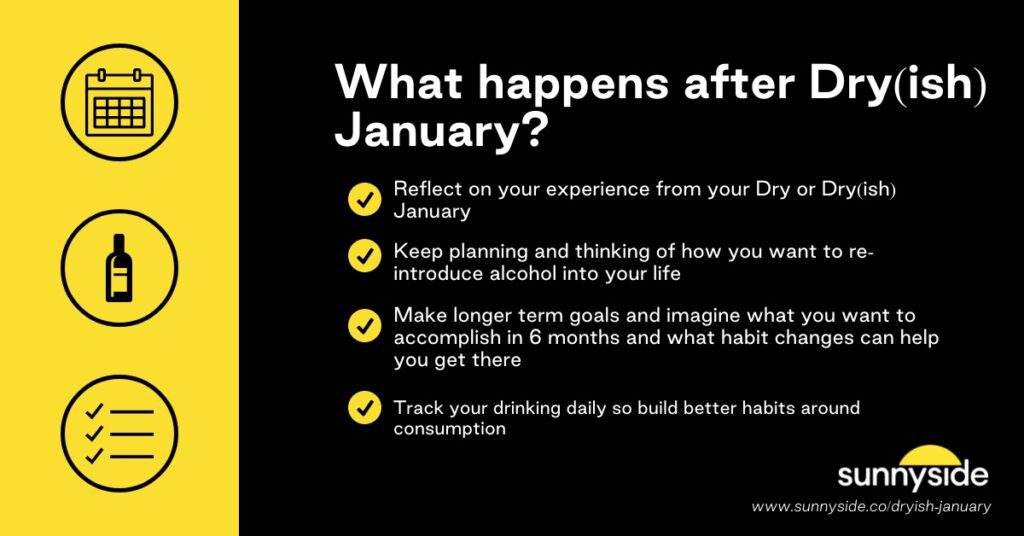

What Sunnyside’s Dry(ish) January Challenge Offers You
If you have tried Dry January (or “Sober October”) in the past and “failed,” or if the idea of giving up alcohol completely for just a month doesn’t excite you, don’t be hard on yourself. Just because something is popular doesn’t mean it’s the right solution for you. Instead you might be better suited for a Dry(ish) January.
So often we tend to think of life in stark and rigid terms. In order to lose weight, for instance, we deny ourselves sugar in nearly all its forms for a couple weeks only to suddenly realize that it’s not sustainable. We end up denying ourselves simple pleasures or feeling ashamed because we raided the cookie jar.
If you’re willing to change your way of thinking, and try this approach, there’s great news. Sunnyside can help you succeed – not in the form of a one-month challenge, but in lasting habit change.
Even small changes in your drinking habits can have a profound impact on your health and wellness. And that’s exactly where we come in. Our system (and our experienced, supportive coaches) can help you evaluate your relationship with alcohol and create a clear action plan that will accelerate your health and wellness goals. Unlike Dry January, our system isn’t an all-or-nothing approach. Rather it’s a strategy with a proven success record for impactful, lasting change. Put simply, mindful drinking is about prioritizing your overall health and experience over keeping up with the crowd. And we’re here to help you, no matter the day, week or month.




Conclusion
Whether you choose to follow a Dry or Dry(ish) January, know that you are supported and have a multitude of tools and resources available to you. With millions of people taking part every year, you can join along and become a part of a positive community that’s ready to motivate you anytime you need. You don’t have to do it alone, and you don’t have to commit to anything you’re not ready for, either.
Follow along in our Facebook group, The Mindful Drinkers to connect with fellow challengers and coaches, and watch to see how your progress is coming along. You might be amazed at the difference that comes from just tracking your habits and noticing how much it affects you. Sign up for the app to get started and by the end of January, you’ll see just how far you’ve come. Get your free 15-day trial
Dry January 2024 FAQ
Here are some of the top questions people are asking about how to manage Dry January 2024:
A slip-up does not equal failure, it’s part of the journey. No one can avoid setbacks, and for good reason — they help us learn, reflect, and reassess. The goal is to understand your relationship with alcohol better, not to achieve the impossible: perfection. Let your slip-ups guide you toward what works and what doesn’t — and practice self-compassion.
You can most definitely do Dry January without an app, the choice is yours. The reason why apps like Sunnyside are helpful is because they offer something crucial: realistic goal-setting, accountability, tools and resources, and a supportive community. It’s not just for temporary motivation, the science-backed tools used can make long-lasting change.
Post-January is all up to you. Many participants decide to go forward more mindfully and stay observant of their habits. Some choose to continue sobriety, while others reintroduce themselves to alcohol with a more moderate approach. It’s important to regularly check in and see how your habits are going throughout the year.
You don’t have to stay on the couch hidden under a blanket if you don’t want to. There are plenty of alcohol-free activities you can do with friends. Plus, it could be a great excuse to push yourself to try something new, like a dance, photography, art, cooking, or writing class — whatever sounds fun and will get you meeting new people.
Go through this article about how to let others know you want to drink more mindfully. Think about simple responses that will help you in pressure-filled situations (practice them with a supportive friend if you like). Being direct and assertive, without being confrontational, is a healthy way to handle peer pressure. So be confident in your decision and prepare phrases that you feel comfortable using.
If you aren’t getting the respectful response you deserve, it could also be time to seek out more supportive communities that share similar goals to yours.
